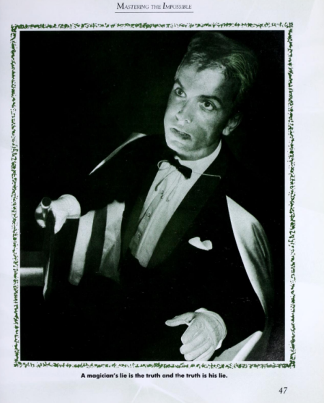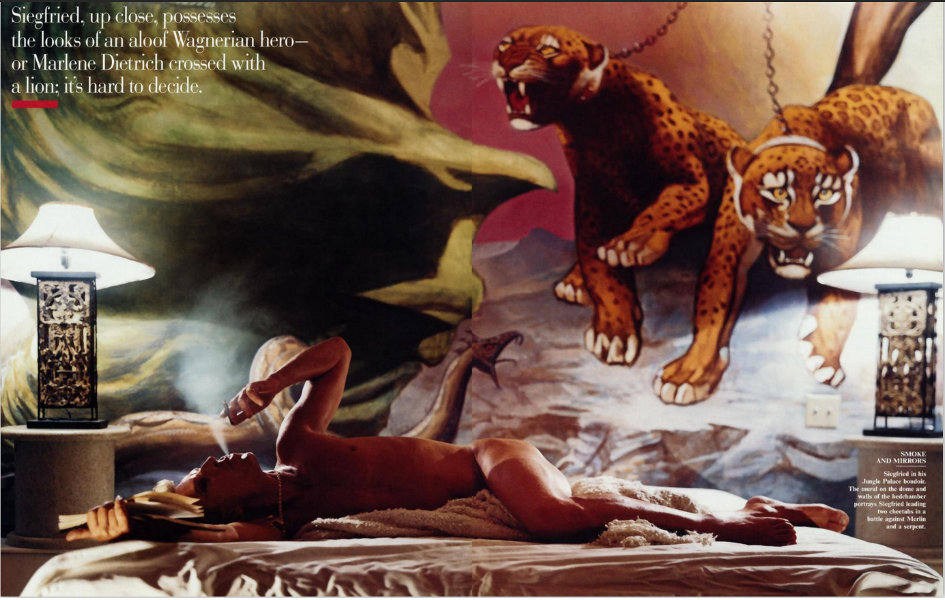Part II, inspired by Apple’s Podcast Wild Things. Siegfried & Roy
Author: Dr. Katrin Horn
March 2022

Apple describes the podcast as “Steven Leckart, in his very first podcast, takes you behind the velvet curtain to reveal shocking moments, surprising details, and hidden truths about two men who were lionized by millions of fans, lampooned by the media, criticized by animal welfare advocates, and endlessly scrutinized by the public”
Wild Things, Apple’s most recent original podcast, promises to take listeners “behind the velvet curtain” and to “reveal … hidden truths” about Siegfried Fischbacher (1939–2021) and Uwe Ludwig Horn (1944–2020), two German emigrants1For more on this aspect of their career and appeal, see the insightful response to Wild Things by Adrian Daub, in Zeit Online: „Siegried und Roy: Zwei Leben wie ein Traum, hemmungslos in die Wirklichkeit gezaubert“. (Do not read the comments section – it’s not a humanities-supportive space.) to the U.S. and Las Vegas illusionists, better known by their stage name Siegfried & Roy. In typical true-crime fashion, the podcast teases listeners with the promise of new evidence and fresh insights about the infamous incident when Roy was attacked by his tiger Montecore during a live performance in 2003, which left him partially paralyzed. While this is the main draw, at least one episode (“Rumors and Ridicule”) focusses on the “hidden truth” that has characterized their lives as celebrities for a lot longer: Siegfried and Roy’s queerness.
In Part I of my thoughts on the closet’s failed knowledge inspired by hulu’s gay rom com Happiest Season, I had envisioned a part II which would offer a diachronic perspective on celebrity gossip’s treatment of queer celebrities all the way back to the nineteenth century. This post will offer instead a little detour into the 1990s: Siegfried and Roy’s treatment by the press from the height of their celebrity up until now, is a master class in how mainstream media is stuck in the epistemic dichotomy of the closet: in or out, hidden or open, truth or lie – following a logic in which “gayness is always placed not as the simple parallel to heterosexuality but as its hidden other” (Walters, The Tolerance Trap, 68).
In the duo’s biography Mastering the Impossible, one image caption reads “A magician’s lie is the truth and the truth is his lie.” That comes pretty close to Philip Core’s definition of camp as “the lie that tells the truth” – which leads us far away from binary oppositions of hiding and exposing, and instead towards a much queerer understanding of the closet and its knowledge.

by Siegfried Fischbacher, Roy Ludwig Horn, and Annette Tapert, p. 47
Another definition of camp, this one by Jack Babuscio, suggests that camp is the queer sensibility which allows us “to perceive the deep significance of appearances – a sumptuous surface that serves not as an empty and meaningless background, but as the very subject” (31). Babuscio here describes Josef von Sternberg’s films, more particularly, his staging of Marlene Dietrich. But he might as well talk about Siegfried & Roy. The lavish stage productions with the over-the-top visual effects, giant props and numerous dancers, melodramatic score, and larger-than-life costumes that taken together supposedly tell a story of deep spiritual significance, while two grown men make wild animals disappear only to cuddle with them? That’s camp. But that’s not all. Their personal lives – or at least what they presented as their personal lives to the public – were no less extravagant, flamboyant, or camp than what they did night after night on stage for almost 40 years. They were two men who lived together in a showy villa called the Jungle Palace in Las Vegas, surrounded by a menagerie of exotic animals, who made it part of their public personae to stress how long they’ve known each other and how much they mean to each other. Which makes one wonder: What exactly is the “hidden truth” journalists keep promising to unveil? What makes them assume the “sumptuous surface” is un-truthful?
To a certain extent this search for the presumably authentic self is just par for the course of celebrity culture in which authenticity ‘‘is established or constructed in media texts by use of markers that indicate lack of control, lack of premeditation and privacy” and which thus continuously “return[s] us to notions of the truth being behind or beneath the surface’’ (Dyer 137). For queer celebrities, however, this truth supposedly hidden behind a public surface boils down primarily, almost exclusively, to a question of sexual identity. In this context, “not hiding” is simply not enough. Puzzled by the same conundrum, The Advocate (one of the leading LGBTQ-magazines in the U.S.) published an article in 2003 (shortly after Roy’s hospitalization, when public interest in the two magicians peaked) and titled it “The Truth About Siegfried and Roy.” In it, the author notes: “Siegfried and Roy have always been master illusionists, both on the stage and off. Sure, making a 600-pound white tiger disappear in the blink of a pyrotechnic is impressive, but it’s the way that the pair have managed over the years to become the world’s most openly closeted celebrities that’s truly awe-inspiring.”
This parallelism between their magic acts and their lives is something the duo themselves emphasized repeatedly in stage banter and interviews, but maybe most overtly in their Imax movie The Magic Box. Here, flashbacks to re-enactments of pivotal moments in their youth in post-war Germany fade into scenes from their Las Vegas production. There are also parallels of a different kind: a key ‘gasp moment’ in their show is a reveal in which the audience expects Roy to ‘magically’ appear in a glass box dangling over the stage. Siegfried instead reveals a tiger. In the 1994 ABC special Siegfried & Roy. The Magic. The Mystery, the camera glides through the Jungle Palace, lets us marvel at the sumptuous, ‘over-aestheticized’ (to return to Babuscio) interiors and then invites us into Roy’s bedroom. Viewers are teased with the big reveal – “who is he sharing his bed with?!” – only to meet Roy cuddling with one of the white tigers. It’s a brilliant over-the-top response to the numerous home stories of heterosexual stars who highlight their down-to-earthness by having a labrador lick their face during the tour of the home – and a poignant reminder that the straight home-stories are usually just as asexual, only less spectacularly so.
Can you hide less and be even more “openly closeted” than that?
Yes, it turns out, indeed you can:

or Marlene Dietrich crossed with a lion; it’s hard to decide”
(Vanity Fair, “Married, with Tigers,” August 1999)
In a 1999 Vanity Fair spread titled “Married, with Tigers,” Siegfried poses naked in front his nude self-portrait (of which the photograph shows only two cheetahs on leashes). The image caption likes him to Marlene Dietrich. The highly suggestive title, “Married, with Tigers,” is spread across an image of Roy and Siegfried, sitting across from each other with naked torsos, looking attentively into each other’s eyes. The article has their friend, actress Shirley MacLaine, blatantly stating that “the way they deal with the perception of them as a couple is as much sleight of hand as their act … they used to be lovers a long time ago.” Nowhere in the article (or any other interview) is this record ‘set straight’ by either Siegfried, Roy, or their manager. The closet is supposed to be a spatial metaphor of concealment, darkness, often even of self-denial, which begs the question: If your closet is decorated with frescos and glitter, and you invite guests into it: is it still a place of hiding?
There is an argument to be made for the political relevance, especially so close still to the height of the AIDS crisis in the U.S., of coming out as “a recognition of social solidarity in the face of both institutional and individual animus” (Walters, Tolerance Trap, 70). There is also an argument to be made for refusal: “For being ‘out’ always depends to some extent on being ‘in’; it gains its meaning only within that polarity” (Butler 16). In other words: every coming out is a performative act in which the closet is created again – if not for the person outing themselves, but rather for someone else, who does not meet the re-affirmed ‘threshold’ of explicitness dictated by mainstream media (as a stand-in for heteronormative society). Or as Melissa Jane Hardie argues in her analysis of media reactions to Lindsay Lohan’s same-sex relationships: “traditional media were more concerned with the stimulating effect of a closet epistemology than in the matter of ostensible report, which is, of course, precisely that mechanism of ignorance that the oscillations of closet epistemologies engender” (Hardie 65). Read as such, ‘outness’ is more easily recognized as the media effect that it is rather than the personal choice it is presented to be. Mainstream media reports present Siegfried and Roy as closeted through their own projected ignorance, which in turn allows them to present Siegfried and Roy as ‘failing’ to come out, as failing to show their truth. To “uncover ‘the true self’” of a profiled star is as essential to celebrity journalism as a product (see Marshall 320) as “self-disclosure” is (increasingly) a core requirement of star labor (see Leonard and Negra 31). In fact, celebrities have always been mass-mediated opportunities for projections of intimacy, and a key pleasure offered by celebrity cultures lies “in interpreting the public figure’s true self, which remains unknowable” (Carr O’Neill 8). Yet, as The Advocate puts it (Daub makes a similar claim in Zeit Online), there is no indication that Siegfried and Roy ‘lived their lives untruthfully’ – there is, however, plenty of indication that they refused the truth-as-depth-model of mediated confessionals in favor of a camp embrace of surface as all there is to know.
Notes:
- 1For more on this aspect of their career and appeal, see the insightful response to Wild Things by Adrian Daub, in Zeit Online: „Siegried und Roy: Zwei Leben wie ein Traum, hemmungslos in die Wirklichkeit gezaubert“. (Do not read the comments section – it’s not a humanities-supportive space.)
Works Cited:
Babuscio, Jack. “Camp and the Gay Sensibility.” Camp Grounds. Style and Homosexuality, edited by David Bergmann, U of Massachusetts P, 1993, pp. 19–38.
Butler, Judith. “Imitation and Gender Insubordination.” Inside/Out: Lesbian Theories, Gay Theories, edited by Diana Fuss, Routledge, 1991, pp. 13–31.
Carr O’Neill, Bonnie. Literary Celebrity and Public Life in the Nineteenth-Century United States, U of Georgia P, 2017.
Core, Philip. Camp. The Lie that Tells the Truth. Plexus, 1984.
Dyer, Richard. “A Star is Born and the Construction of Authenticity.” Stardom. Industry of Desire, edited by Christine Gledhill, Routledge, 1991, pp.132–140.
Hardie, Melissa Jane. “The Closet Remediated: Inside Lindsay Lohan.” Australian Humanities Review, vol. 48, 55–70.
Leonard, Suzanne and Diane Negra. “Celebrity.” Keywords for Media Studies, ed. by Laurie Ouellette and Jonathan Gray, NYU Press, 2017, pp. 28–31.
Marshall, P. David. “Intimately Intertwined in the Most Public Way. Celebrity and Journalism.” The Celebrity Culture Reader, edited by P. David Marshall, Routledge, 2006, pp. 315–323.
Walters, Suzanna Danuta (2014). The Tolerance Trap. How God, Genes, and Good Intentions are Sabotaging Gay Equality. New York: NYU Press.
